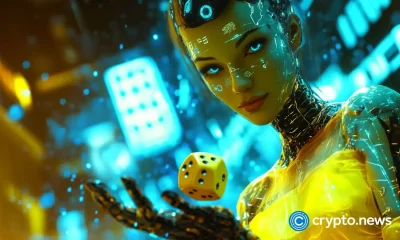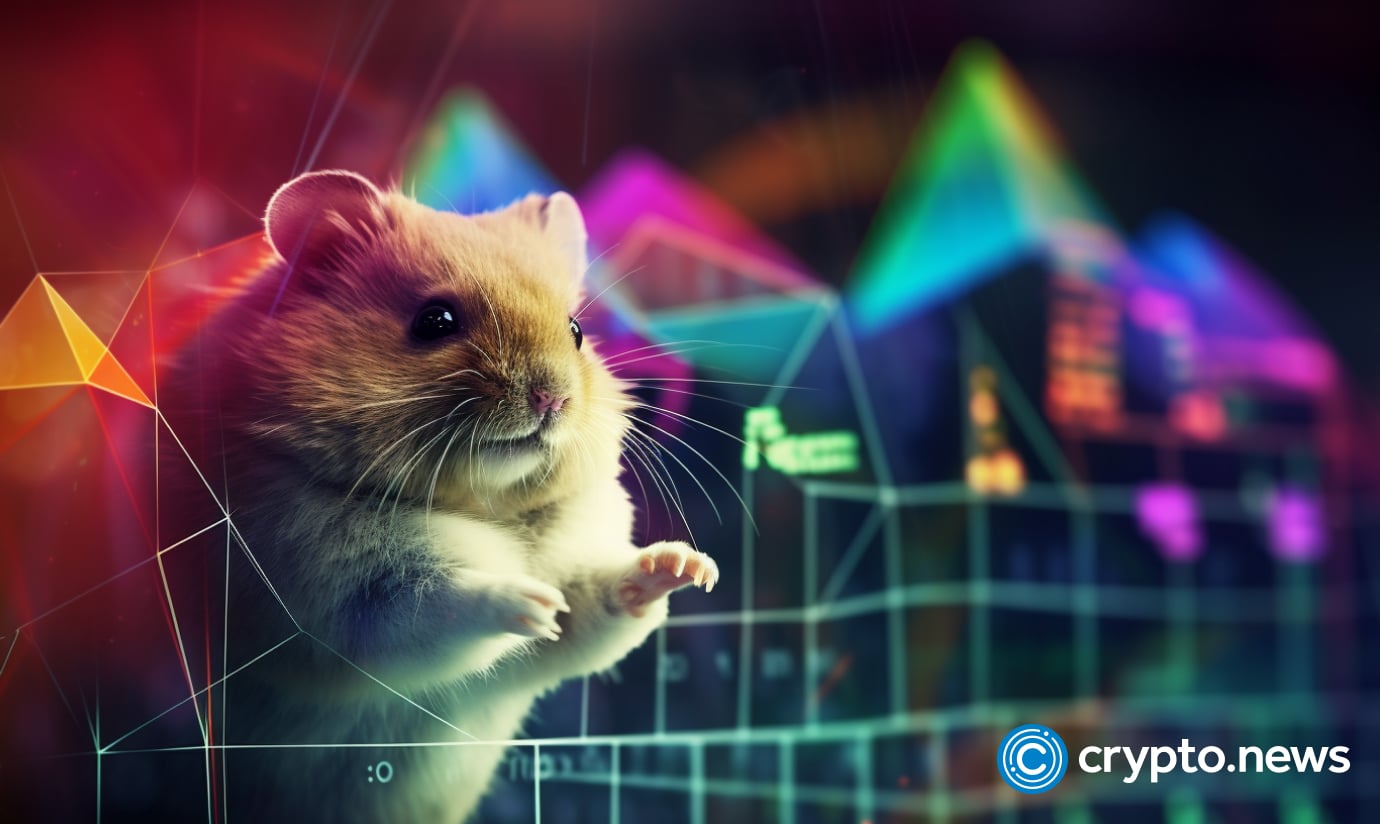blockchain games
Web3 gaming adoption is driven by platforms like Telegram
Published
2 months agoon
By
admin

A recent report commissioned by Elympics, a Web3 gaming protocol, highlighted how Telegram and blockchain technology have transformed the gaming world.
The research report, shared with crypto.news and based on feedback from nearly 1,000 global gamers, shows how platforms like Telegram and the rise of “compete-to-earn” games are driving the adoption of Web3 gaming.
The success of Telegram as a gaming platform was evident in the survey results, with 53.56% of players choosing it as their preferred platform for playing mobile games. This highlights Telegram’s growing influence in the gaming space and its ability to attract a large, engaged player base.
Most respondents, 78.77%, reported playing games daily, while 15.19% indicated they play a few days a week.
With the rise of competitive gaming, the report delved into the impact of blockchain games and their community-driven advances on the gaming industry.
“Our research shows that with the entry of social platforms such as Telegram into the Web3 world and the skill games growth with community-driven money competitions, we are seeing the start of mass adoption by players around worldwide. Gamers enjoy winning through competition so we build games meeting this need.”
Tom Kopera, COO of Elympics
Traditionally, games have been centralized, meaning a company controls the game’s development, design, and rules. In blockchain games, the power is more decentralized—players have more control, and they can own in-game assets that can’t be easily tampered with.
“Blockchain decentralizes the ownership, turning players into investors of time and money into their beloved games.”
Stan Fiedor, General Manager Europe of Wemix
This ownership includes everything from virtual items to characters to NFTs, which are stored on a blockchain and can even be traded outside of the game.
Mass adoption of blockchain games
One of the major points in the report is how these new games can transform mobile gaming. Blockchain-based mobile games offer players the chance to monetize their skills and gameplay, turning a previously passive activity into one with financial rewards.
The report noted that blockchain gaming is on the verge of mass adoption, with “a growing interest from gamers eager to participate,” according to Michał Dąbrowski, CEO of Elympics.
However, the report noted that Web3 gaming is still overcoming skepticism due to the flaws of its earlier versions. Initial blockchain games faced issues like poor design and broken in-game economies.
According to the survey, the most common reason for not playing blockchain games is uncertainty about how to get started, with 32.11% of respondents citing that they “have no idea how to start.”
Today, the industry has learned from some of these mistakes, with developers focusing on creating better games with solid economic models that encourage fair play and real ownership of digital assets. Elympics believes that, by adding real-world stakes to gaming, Web3 could be the next big shift in the industry.
TON and Telegram
TON (TON) and Telegram have embraced blockchain to drive engagement and revenue without compromising user trust, the report noted. TON has become a popular hub for hyper-casual games like Notcoin (NOT) and Hamster Kombat, attracting millions of users.
Telegram’s simplified crypto wallet, automatically integrated for non-US users, eliminates barriers to entry, helping onboard millions of real users effortlessly.
Blockchain games on TON appeal to both casual and competitive gamers, offering a seamless experience that feels no different from traditional Web2 games.
The report concluded that platforms like Telegram are helping to bridge the gap between Web2 and Web3, creating an ecosystem where players may not even realize they are engaging with blockchain technology.
Source link
You may like


Axie Infinity developer cuts 21% workforce: report


Chill Guy Meme Coin Pumps Another 50% as Creator Fights Back


Super Pepe Coin Whale Sells 130B PEPE, Shifts Focus To EIGEN


AI predicts one altcoin set to outperform XRP and Solana in 2025


BTC and Major Altcoins Pullback, SAND Soars 60%


Трамп обирає менеджера прокрипто-хедж-фонду Скотта Бессента на посаду міністра фінансів
Axie Infinity
Axie Infinity developer cuts 21% workforce: report
Published
2 hours agoon
November 25, 2024By
admin

Axie Infinity creator Sky Mavis lays off 50 employees as part of broader efforts to adapt post-hack and market shifts.
Sky Mavis, the developer of the blockchain-based game Axie Infinity, said it will lay off 21% of its staff — or roughly 50 employees — as part of efforts to streamline operations and focus on core products, TechInAsia has learned.
The firm’s co-founder Nguyen Thanh Trung emphasized in an X post that the decision was not driven by financial pressures, reassuring that the decision is a “strategic move that allows for a sharper focus and positioning Sky Mavis for hypergrowth in 2025 and beyond.”
“The decision to part ways with talented team members was not made lightly and does not reflect their contributions to Sky Mavis. […] In order to better focus on these products and have the agility needed to open Ronin in Q1, we have made the tough decision to let go of 21% of our workforce.
Nguyen Thanh Trung
Trung also shared that Sky Mavis would not pursue new directions, stating, “rather than trying to build products for all users, we are doubling down on what makes Sky Mavis truly exceptional.” As a result, the game developer will focus on the Ronin wallet and expanding the Ronin Network “for more builders.” Following the news, the price of the Axie Infinity (AXS) token plunged 3.78%.
Founded in 2018, Sky Mavis operates a play-to-earn model where players purchase monsters as well as earn non-fungible tokens and in-game currency. In 2022, North Korea-affiliated hackers launched a multi-level social engineering attack on the company, leading to a $600 million loss. In response, Sky Mavis shifted to a free-to-play model.
Source link
blockchain games
HashCats prepares for Token Generation Event after completing mining season
Published
4 days agoon
November 21, 2024By
admin

HashCats, a tap-to-earn miner game, is concluding its first season and shifting focus to its upcoming Token Generation Event.
With nearly five million players engaged in the game’s first six months, HashCats has announced a $500,000 giveaway in collaboration with its partner Choise.ai to reward players ahead of this next phase, according to a release shared with crypto.news.
T2E games, which allow users to earn cryptocurrency by playing, have gained attention but faced challenges in maintaining long-term engagement. Games like Hamster Kombat and Catizen (CATI) initially sparked hype but have struggled to sustain user interest.
HashCats is trying to buck this trend by expanding its ecosystem and enhancing player incentives.
HashCats background
Tap-to-earn games let users generate cryptocurrency by playing simple games. In HashCats, players mine $HASH tokens by tapping their screens and upgrading virtual mining equipment. These tokens can then be converted into cryptocurrency or used within the game’s ecosystem.
Unlike traditional games that charge for upgrades, T2E games aim to provide a potential income stream for players.
Season 1 of HashCats introduced basic mining mechanics, enabling players to use a single virtual ASIC miner designed for mining specific digital currencies based on their hashing algorithms.
According to the release, Season 2 will expand this concept, enabling players to manage a full mining farm and introducing Secret Points, which boost TGE rewards. Players from Season 1 who accumulated SP through contests and giveaways will gain an advantage in the new phase.
HashCats and Choise.ai Collaboration
The partnership with Choise.ai, a platform that merges traditional finance with blockchain, adds an extra layer of incentives.
The ongoing $500,000 giveaway includes events like the “Wheel of Fortune” contest, where players can win CHO tokens. Choise.ai also plans to launch Visa and Mastercard options tailored for HashCats players.
Source link
blockchain games
Hamster Kombat Ended in a Mass Exodus of 260 Million Players
Published
3 weeks agoon
November 6, 2024By
admin

Did Hamster Kombat’s viral rise lead to its own downfall? How did 260 million players vanish in months, leaving the game a shadow of its former self?
From boom to dust
Hamster Kombat (HMSTR), a once-celebrated tap-to-earn game on Telegram, seemed destined for blockchain gaming fame, amassing a jaw-dropping 300 million users within months of its launch in March 2024.
But in a surprising twist, this viral sensation has seen an 86% nosedive in active users, dropping to just 41 million by November 2024 and facing one of the most dramatic declines in crypto gaming history.
.@hamster_kombat loses nearly 260 million players in just three months
Hamster Kombat, the tap-to-earn Telegram game that boasted a massive 300-million-strong user base back in August, has reportedly shed 259 million players.
The game’s active monthly player count currently… pic.twitter.com/vVfwhbI4E6
— ICO Drops (@ICODrops) November 4, 2024
The game’s token, HMSTR, has also plummeted in value by over 76%, sliding from its September high of $0.01004 to just $0.0024 as of Nov. 5, casting doubts over the project’s stability.
Behind this exodus lie a series of interconnected setbacks: delayed airdrops, poor user experience, government criticisms, and controversial player bans.
Could the game’s ambitious goals have been the very seeds of its undoing? Let’s delve into the numbers, the strategies, and the backlash to find out what led to Hamster Kombat’s colossal fall from grace.
The rise and promise of Hamster Kombat
Hamster Kombat launched with an ambitious promise: to make blockchain gaming accessible to everyone. A big part of the game’s appeal lies in its simplicity. No need for gaming consoles, advanced computers, or complex controls — players simply tapped, and in return, they earned.
Even Telegram’s CEO, Pavel Durov, hailed it as “the fastest-growing digital service in the world,” citing its potential to redefine how people interacted with blockchain technology.
People from all over the world were suddenly part of this booming virtual ecosystem, where tapping became the new mining, and the tokens they collected had real value attached.
But the game itself couldn’t keep players engaged. The initial excitement over the tap-to-earn model quickly faded as players found the gameplay repetitive and shallow.
With no fresh challenges, Hamster Kombat began to lose its appeal, leaving users with little reason to return, especially as the HMSTR token kept losing value.
The AI-generated graphics, which initially seemed quirky, were also criticized for feeling cheap and uninspired, adding to the perception that Hamster Kombat was more of a cash grab than a well-crafted gaming experience.
The simplicity that first drew users in became a source of frustration, and the game’s high hopes for sustainability faced challenges that even a massive user base couldn’t fix.
The airdrop disappointment and the backlash of bans
One of Hamster Kombat’s most eagerly awaited events was its token airdrop in late September, intended as a reward for player loyalty and engagement.
With nearly 129 million players eligible to claim HMSTR tokens, expectations ran high. But what was meant to be a celebratory event ended up driving players away in droves.
The airdrop left many users frustrated, not just because of delays but due to the surprisingly low value of their rewards.
Some players who had spent hours grinding the game found their earnings amounted to just $1 to $10 — a fraction of what they’d hoped for, leading some to label the airdrop as “dust.”
To make matters worse, the rollout of the airdrop was marred by delays and technical glitches. Originally promised as a straightforward distribution, the airdrop faced several postponements, testing players’ patience.
By the time it finally happened, the discontent among the user base was palpable. Many players took to social media to vent their frustrations, some claiming they felt deceived by what they saw as broken promises.
This backlash severely damaged the game’s reputation, transforming the airdrop from an incentive to a point of contention.
The controversy didn’t end there. Hamster Kombat introduced a new anti-cheat system alongside the airdrop, aiming to curb fraudulent activities.
While intended to protect genuine players, this system ended up banning around 2.3 million accounts and confiscating approximately 6.8 billion HMSTR tokens. Many players felt blindsided by these sudden restrictions, as even legitimate users were caught in the dragnet.
Some felt that the sweeping bans were too harsh, and the confiscations only added to the resentment, leaving a large chunk of the player base feeling alienated and mistreated.
The fallout was swift. The airdrop disappointment, combined with the massive bans, fueled a wave of user departures. By early November, Hamster Kombat’s once-formidable user base had dwindled to just 41 million monthly active players, a fraction of its 300 million peak.
Government scrutiny and the ripple effect of public doubt
Hamster Kombat’s rapid rise wasn’t just on players’ radar — it also attracted the attention of governments, and not always in a positive way.
In some regions, officials expressed concern over the game’s influence, viewing it as more than just a harmless pastime. As its user base swelled, so did the scrutiny, with some authorities labeling the game as a “disruptive force” in their societies.
In Iran, the backlash was particularly strong. The game caught the attention of the country’s military officials, who were concerned that Hamster Kombat was drawing attention away from political matters.
One Iranian military deputy chief went so far as to call it a “soft tool” being used by the West to distract citizens from national priorities and weaken the country’s religious governance, positioning it as a digital disruptor with intentions beyond simple entertainment.
The situation was similar in Russia, where the chairman of the State Duma Committee took an even harsher stance, branding Hamster Kombat as a “scam”, and called for an outright ban.
The developers of Hamster Kombat have also had to address their connection with Gotbit, a crypto market maker now under investigation for fraud in the U.S.
As the authorities filed charges against Gotbit for market manipulation, Hamster Kombat publicly distanced itself from the company.
Dear CEOs,
We are committed to ensuring transparency within the Hamster Ecosystem.
In light of recent news regarding Gotbit, we want to clarify that Hamster Kombat has never worked with Gotbit as a market maker.
— Hamster Kombat (@hamster_kombat) October 12, 2024
Despite these efforts, users have continued to question the stability of the HMSTR token, which has already experienced a stark drop in value.
What’s next for HMSTR?
The sharp downturn in Hamster Kombat’s player base and token price has left many in the crypto community asking: is this just a stumble, or has the game reached a point of no return?
One of the most pressing concerns is a breakdown in trust, with disappointed users feeling that Hamster Kombat has “betrayed the trust of its community.”
❌ Enough is Enough Hamster Kombat ❌
Hamster Kombat has betrayed the trust of its community through deceptive practices, prioritizing influencers over genuine users. It’s time to hold them accountable and demand justice.
😥😥🙏🙏💯🤝 pic.twitter.com/nBaGHRPYQz— Caleb (@Canny5b23n) November 2, 2024
The backlash stems from a perception that the game prioritized influencer partnerships and flashy marketing over a genuinely user-focused experience.
Many early adopters, who initially hoped for long-term rewards, are now disillusioned by broken promises, delayed airdrops, and the steady devaluation of the token.
One disappointed player noted they left after the first season, saying they had “so much hope” for the game but ultimately felt let down by the experience.
I personally left the game after the disappointed me in the first season, i had so much hope but they made it short 🥺
— Millie (@origanalybohay) November 5, 2024
Another major worry has been the ongoing decline in the value of the HMSTR token. As one observer put it, the token’s price chart is “in freefall,” with many users predicting that exchange delistings are “probably around the corner.”
This prediction isn’t baseless; projects unable to sustain interest or stabilize token value often find themselves sidelined by major exchanges due to low trading volume and high volatility.
For Hamster Kombat, rebuilding user trust and stabilizing the HMSTR token will demand not only operational adjustments but also clear communication. This includes rethinking gameplay mechanics, enhancing reward quality, and building genuine engagement with the community.
The broader takeaway here is that crypto games must go beyond promises to deliver real value if they want to survive the increasingly skeptical eyes of their audiences.
Source link

Axie Infinity developer cuts 21% workforce: report

Chill Guy Meme Coin Pumps Another 50% as Creator Fights Back

Super Pepe Coin Whale Sells 130B PEPE, Shifts Focus To EIGEN

AI predicts one altcoin set to outperform XRP and Solana in 2025

BTC and Major Altcoins Pullback, SAND Soars 60%

Трамп обирає менеджера прокрипто-хедж-фонду Скотта Бессента на посаду міністра фінансів

Trump calls up crypto pals, Senator says sell gold for Bitcoin | Weekly Recap

Where to Invest in November End?

XRP Price Hits 3-Year High At $1.6

Australia seeking advice on crypto taxation to OECD

Crypto Trader Records $2.5M Profit With This Token, Here’s All

Trump taps crypto bros to be in charge: What’s at stake?

Charles Schwab Looking at Spot Crypto Trading Following Regulation Shift: Report

Here’s Why XRP Price Will Hit $20

3 cryptos under $0.5 that experts believe could deliver 1500% returns
182267361726451435

Why Did Trump Change His Mind on Bitcoin?

Top Crypto News Headlines of The Week

New U.S. president must bring clarity to crypto regulation, analyst says

Ethereum, Solana touch key levels as Bitcoin spikes

Bitcoin Open-Source Development Takes The Stage In Nashville

Will XRP Price Defend $0.5 Support If SEC Decides to Appeal?

Bitcoin 20% Surge In 3 Weeks Teases Record-Breaking Potential

Ethereum Crash A Buying Opportunity? This Whale Thinks So

Shiba Inu Price Slips 4% as 3500% Burn Rate Surge Fails to Halt Correction

‘Hamster Kombat’ Airdrop Delayed as Pre-Market Trading for Telegram Game Expands

Washington financial watchdog warns of scam involving fake crypto ‘professors’

Citigroup Executive Steps Down To Explore Crypto
Mostbet Güvenilir Mi – Casino Bonus 2024

Bitcoin flashes indicator that often precedes higher prices: CryptoQuant
Trending

 2 months ago
2 months ago182267361726451435

 Donald Trump4 months ago
Donald Trump4 months agoWhy Did Trump Change His Mind on Bitcoin?

 24/7 Cryptocurrency News3 months ago
24/7 Cryptocurrency News3 months agoTop Crypto News Headlines of The Week

 News3 months ago
News3 months agoNew U.S. president must bring clarity to crypto regulation, analyst says

 Bitcoin4 months ago
Bitcoin4 months agoEthereum, Solana touch key levels as Bitcoin spikes

 Opinion4 months ago
Opinion4 months agoBitcoin Open-Source Development Takes The Stage In Nashville

 Price analysis4 months ago
Price analysis4 months agoWill XRP Price Defend $0.5 Support If SEC Decides to Appeal?

 Bitcoin4 months ago
Bitcoin4 months agoBitcoin 20% Surge In 3 Weeks Teases Record-Breaking Potential


